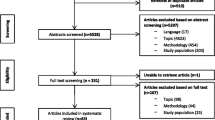Abstract
Purpose of Review
Social support is an important yet often overlooked aspect of chronic pain management. Understanding the impact of social support on patients with chronic pain and determining if a relationship exists between a patient’s perceived social support and their perceived quality of life is a crucial component to completely treating a pain patient. We sought to develop an intervention for patients with chronic pain that addresses the different types of social support, barriers to using social support, and ways to improve the quality of their social support.
Recent Findings
A retrospective review of a prospectively collected database was utilized in an Outpatient Chronic Pain Rehabilitation Program with 23 patients with a chronic pain diagnosis who participated in a 3-week comprehensive pain rehabilitation program. Evaluation, intervention, and discharge were evaluated utilizing The American Chronic Pain Association’s Quality of Life Scale and The Canadian Occupational Performance Measure (COPM). The intervention phase comprised a 45-min group session. At discharge, the occupational therapist followed up with the patient regarding the results of their social survey.
Summary
Overall, the results indicated an underutilization of social support among patients with chronic pain. Out of the four questions asked on the social support survey, patients scored their use of tangible support (Q2) as the lowest. No significant positive correlation (0.27) was found between social support and quality of life which can be attributed to the wide variety of patients seen at the PRC. Social support is an essential part of chronic pain treatment and should be addressed throughout all stages of pain management.

Similar content being viewed by others
References
Papers of particular interest, published recently, have been highlighted as: •• Of major importance
•• Carpenter L, Baker GA, Tyldesley B. The use of the Canadian occupational performance measure as an outcome of a pain management program. Canadian Journal of Occupational Therapy. 2001;68(1):16–22 The Canadian Occupational Performance Measure records self-reported changes in occupational performances. It is widely used to assess functional improvement in patients.
•• Cowan P, Kelly N. Quality of life scale: a measure of function for people with chronic pain. [Assessment instrument]. Rocklin: The American Pain Association; 2003. The Quality of life scale is another means to measure a patient’s functional capacity rather than relying on pain scores.
Franks HM, Cronan TA. Social support in women with fibromyalgia: Is quality more important than quantity? Journal of Community Psychology. 2004;32(4):425–38.
Institute of Medicine. Institute of medicine report from the committee on advancing pain research, care, and education: relieving pain in America, a blueprint for transforming prevention, care, education and research. The. Washington, D.C.: National Academies Press; 2011.
Glanz K, Rimer BK, Viswanath K. Health behavior and health education: theory, research, and practice. San Francisco: Jossey-Bass; 2008.
•• Kurklinsky S, Perez RB, Lacayo ER, Sletten CD. The efficacy of interdisciplinary rehabilitation for improving function in people with chronic pain. Pain Res Treat. 2016, 2016:1–6 This study highlights the importance of functional restoration through a comprehensive pain rehabilitation program. Improvements were shown in the 6 min walk test and Canadian Occupational Performance after enrollment in the 3 week rehabilitation program.
Larson AE, Rasmussen B, Christensen JR. Enhancing a client-centred practice with the Canadian Occupational Performance Measure. Occupational Therapy International. 2018;2018:1–11.
López-Martínez AE, Esteve-Zarazaga R, Ramírez-Maestre C. Perceived social support and coping responses are independent variables explaining pain adjustment among chronic pain patients. The Journal of Pain. 2008;9(4):373–9.
•• Ozbay F, Johnson DC, Dimoulas E, Morgan CA III, Charney D, Southwick S. Social support and resilience to stress: from neurobiology to clinical practice. Psychiatry. 2007;4:35–40 This article supports the fact that social support may influence genetic and environmental vulnerabilities through various neurobiologic systems.
National Cancer Institute. (n.d.). NCI dictionary of cancer terms. Retrieved from www.cancer.gov.
Smite D, Rudzite I, Ancane G. Sense of social support in chronic pain patients. SHS Web of Conferences. 2012;2:1–6.
•• Wang X, Cai L, Qian J, Peng J. Social support moderates stress effects on depression. Int J Ment Health Syst. 2014;8(4):1–5 This study showed that the impact on stress on depression was attenuated in individuals with a higher degree of social support.
Author information
Authors and Affiliations
Corresponding author
Ethics declarations
Conflict of Interest
The authors declare that they have no conflict of interest.
Human and Animal Rights and Informed Consent
This article does not contain any studies with human or animal subjects performed by any of the authors.
Additional information
Publisher’s Note
Springer Nature remains neutral with regard to jurisdictional claims in published maps and institutional affiliations.
This article is part of the Topical Collection on Other Pain
Rights and permissions
About this article
Cite this article
McMurtry, M., Viswanath, O., Cernich, M. et al. The Impact of the Quantity and Quality of Social Support on Patients with Chronic Pain. Curr Pain Headache Rep 24, 72 (2020). https://doi.org/10.1007/s11916-020-00906-3
Accepted:
Published:
DOI: https://doi.org/10.1007/s11916-020-00906-3




